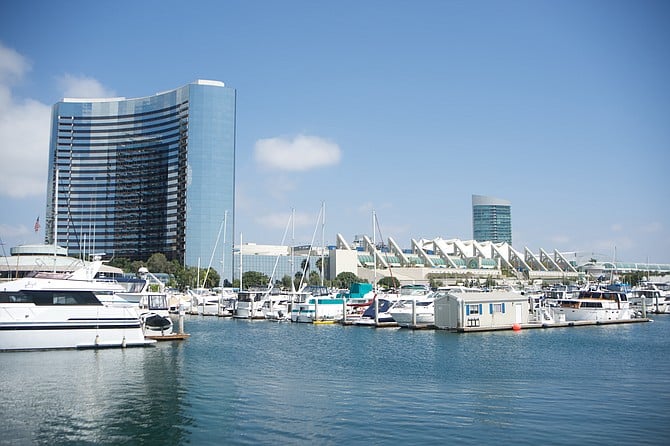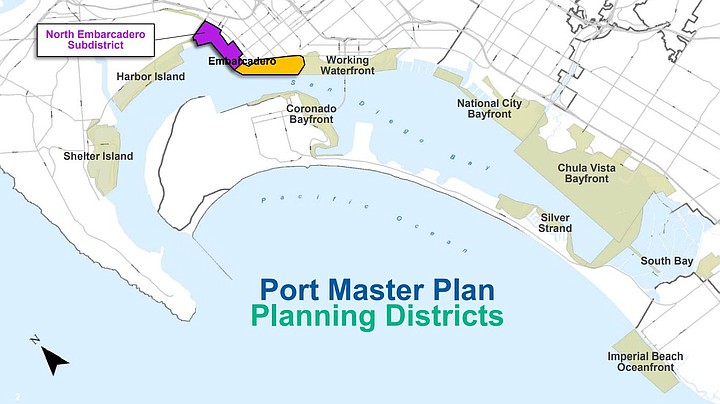 Facebook
Facebook
 X
X
 Instagram
Instagram
 TikTok
TikTok
 Youtube
Youtube

If there's one thing communities around San Diego Bay agree on, it's hotels. They are view-killers, pedestrian blockers, tourist malls. Yet the Port wants more.
When the San Diego Unified Port District, which oversees the 34-mile bay waterfront, released a draft Port Master Plan update last year, comments about hotel expansion poured in. The process began in 2013, was stalled by the pandemic, and has now resumed with revisions expected in late fall.
And downtown, with its 40,000 residents, wants to be heard.
"Remember we live adjacent to Port property, not 1/2 mile away," said the Embarcadero Coalition.

The Port's blueprint is designed to provide as much public access to the coast as possible while protecting natural resources. But under the Port Act, they must plan around the benefit of all Californians, "and may not implement traditional neighborhood or municipal uses."
A massive effort at public outreach has helped refine the draft, however; for example, the Port intends to follow the neighboring jurisdictions’ height limit which will be detailed in the revised draft of the update expected in late fall.
At a meeting on September 2, the Downtown Community Planning Council drafted a letter to the Port about their concerns. A main tenet of the downtown community plan is a diversity of uses, but due to 11,827 hotel rooms proposed from the Hilton to the Wyndham, "any balance has been lost."
Downtown's entire 2.7 mile southern and western borders are adjacent to the Port's waterfront from Laurel St to the 10th Ave Terminal, plus a "front porch" view that stretches to Mexico. The city has established and protected view corridors on several downtown streets.
"Our past and continuing efforts will be entirely wasted if these are not carried to the bay as was intended."
First it was the convention center and three large hotels, drawing a curtain on downtown's southern waterfront. The downtown portion of the bay is now girded by the Bayfront Hilton, convention center, Marriott Marquis, Manchester Grand Hyatt, the Manchester Gateway Development, the Lane Field InterContinental, Springhill Suites, and Residence Inn Hotels.
"Now with the existing and planned 5700 rooms to the west, downtown will be entirely walled off from the bay."
The Embarcadero Coalition, a group of downtown dwellers, urged the port to keep in mind "the residential nature of downtown."
West of downtown, residents complained that new hotels on Shelter Island will cut off the harbor from the residents. And 1600 more hotel rooms on Shelter Island "is just too many for an area with one entrance and exit."
Many worried about a dearth of recreation downtown, and a draft plan that includes more commercial uses. In fact, hotel rooftops can even count as "recreation open space." Opponents pointed out that these spaces "have severely restricted access through private businesses."
The Port doesn't collect tax dollars, but supports parks, promenades, piers and public art by generating revenue from businesses operating on tidelands – like hotels.
Will thousands of new rooms rake in the revenue? Because of competition from Airbnbs, and city rules that allow homeowners to add a rentable second unit easily, hotels may not always be first choice. And business travel may slow in the era of online meetings.
Hotels re-opened in June, but demand for them downtown was lower in August than it was in March when everything shut down, according to the San Diego Tourism Marketing District.


If there's one thing communities around San Diego Bay agree on, it's hotels. They are view-killers, pedestrian blockers, tourist malls. Yet the Port wants more.
When the San Diego Unified Port District, which oversees the 34-mile bay waterfront, released a draft Port Master Plan update last year, comments about hotel expansion poured in. The process began in 2013, was stalled by the pandemic, and has now resumed with revisions expected in late fall.
And downtown, with its 40,000 residents, wants to be heard.
"Remember we live adjacent to Port property, not 1/2 mile away," said the Embarcadero Coalition.

The Port's blueprint is designed to provide as much public access to the coast as possible while protecting natural resources. But under the Port Act, they must plan around the benefit of all Californians, "and may not implement traditional neighborhood or municipal uses."
A massive effort at public outreach has helped refine the draft, however; for example, the Port intends to follow the neighboring jurisdictions’ height limit which will be detailed in the revised draft of the update expected in late fall.
At a meeting on September 2, the Downtown Community Planning Council drafted a letter to the Port about their concerns. A main tenet of the downtown community plan is a diversity of uses, but due to 11,827 hotel rooms proposed from the Hilton to the Wyndham, "any balance has been lost."
Downtown's entire 2.7 mile southern and western borders are adjacent to the Port's waterfront from Laurel St to the 10th Ave Terminal, plus a "front porch" view that stretches to Mexico. The city has established and protected view corridors on several downtown streets.
"Our past and continuing efforts will be entirely wasted if these are not carried to the bay as was intended."
First it was the convention center and three large hotels, drawing a curtain on downtown's southern waterfront. The downtown portion of the bay is now girded by the Bayfront Hilton, convention center, Marriott Marquis, Manchester Grand Hyatt, the Manchester Gateway Development, the Lane Field InterContinental, Springhill Suites, and Residence Inn Hotels.
"Now with the existing and planned 5700 rooms to the west, downtown will be entirely walled off from the bay."
The Embarcadero Coalition, a group of downtown dwellers, urged the port to keep in mind "the residential nature of downtown."
West of downtown, residents complained that new hotels on Shelter Island will cut off the harbor from the residents. And 1600 more hotel rooms on Shelter Island "is just too many for an area with one entrance and exit."
Many worried about a dearth of recreation downtown, and a draft plan that includes more commercial uses. In fact, hotel rooftops can even count as "recreation open space." Opponents pointed out that these spaces "have severely restricted access through private businesses."
The Port doesn't collect tax dollars, but supports parks, promenades, piers and public art by generating revenue from businesses operating on tidelands – like hotels.
Will thousands of new rooms rake in the revenue? Because of competition from Airbnbs, and city rules that allow homeowners to add a rentable second unit easily, hotels may not always be first choice. And business travel may slow in the era of online meetings.
Hotels re-opened in June, but demand for them downtown was lower in August than it was in March when everything shut down, according to the San Diego Tourism Marketing District.
Comments